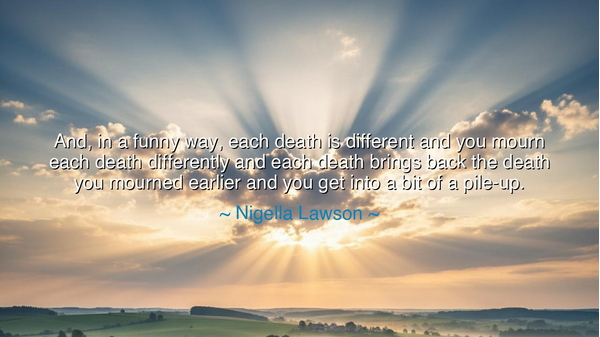
And, in a funny way, each death is different and you mourn each
And, in a funny way, each death is different and you mourn each death differently and each death brings back the death you mourned earlier and you get into a bit of a pile-up.






“And, in a funny way, each death is different and you mourn each death differently and each death brings back the death you mourned earlier and you get into a bit of a pile-up.” — so spoke Nigella Lawson, the eloquent writer and cook whose words, though tender, carry the weight of profound human truth. In this reflection, she does not speak as a celebrity or author, but as one who has walked through the valleys of loss and emerged with the quiet wisdom born only of grief. In her phrase — at once sorrowful and wry — she captures the strange, layered nature of mourning: that grief is not linear, but cyclical; that every new loss reopens the doors to every sorrow that came before.
The origin of this truth lies deep within the human heart, which remembers not in moments, but in echoes. Nigella Lawson, who herself endured the loss of both her mother and her husband, speaks from the lived experience of those who have felt sorrow’s long hand upon the soul. When she says that “each death is different,” she acknowledges that every love we have is singular — each person who departs takes with them a unique piece of our world, and no two absences are the same. Yet, she adds that each new death “brings back the death you mourned earlier,” for grief, like tide to shore, carries the remnants of old pain with every return. Thus, she likens mourning to a “pile-up,” an overwhelming convergence of emotions — sorrow layered upon sorrow, memory upon memory, until the heart feels buried beneath its own past.
To those who have known great loss, this is no mere metaphor, but a living truth. When a friend dies, we weep not only for them, but for every friend we have ever lost. When a parent passes, we feel again the ache of every goodbye we have ever uttered. Grief does not vanish; it transforms. It lies dormant in the quiet chambers of memory until life, in its relentless turning, strikes the same chord again — and the old sorrow stirs, rising like a ghost beside the new. In this, Lawson’s insight reveals the intertwined nature of love and loss: that to love deeply is to grieve deeply, and that grief, though painful, is proof of love’s endurance.
Consider the story of Queen Victoria, who, after the death of her beloved husband Prince Albert, dressed in mourning black for the rest of her life. She could not bear to forget him, nor to cease her sorrow. Yet when others in her life passed away — friends, family, even her own children — she found that her mourning for them was never separate from her grief for Albert. Each loss reopened the same wound, though time and circumstance had changed. She was living, as Lawson describes, in that “pile-up” of mourning — a layered grief, in which the pain of one death could not be untangled from the memory of another. And yet, in that endless grief was a fierce and beautiful truth: love had made her human, and even sorrow could not take that humanity away.
The meaning of Lawson’s words is not despair, but recognition. She does not romanticize death, nor deny its cruelty. Rather, she teaches us to accept the complexity of mourning — to know that it is not neat, not uniform, and not something to “move past.” Each grief demands its own language, its own rhythm. One loss may be quiet and resigned, another raging and raw. One may bring tears; another, numbness. But all are sacred, for they remind us that our capacity to feel pain is bound to our capacity to love. When the new loss awakens the old, it is not a punishment, but a reminder — that love, though wounded, still lives within us.
In her phrase, “in a funny way,” Lawson uses gentle irony to describe something almost unbearable. The word “funny” does not mean humorous here, but strange, humanly absurd — how life entwines our griefs together until we are almost amused by their cruelty. Yet that touch of humor is itself an act of resilience. To find irony in sorrow is not to mock it, but to survive it — to hold grief lightly enough that it does not consume the soul. In this way, her wisdom is not only about loss, but about endurance: the art of living with open wounds and still finding the strength to smile.
Let this, then, be the lesson: when grief comes, do not resist its return. Do not be ashamed that one sorrow awakens another, or that old pain resurfaces when new loss arrives. Such is the nature of love — eternal, circular, persistent. Allow yourself to mourn each death differently, as Lawson says, and let each tear be its own prayer. In doing so, you honor not only the dead, but the living spirit within yourself that remembers and loves.
And when the “pile-up” feels too heavy — when sorrow seems to crush the heart — remember that grief, though cumulative, is also connective. It binds us to every soul we have loved, and even to others who grieve beside us. Out of this shared humanity grows compassion, and out of compassion, peace. For though each death is different, the love that mourns them all is the same — a single, unending river, flowing through all time, carrying with it the sacred memory of every heart that ever dared to love.






AAdministratorAdministrator
Welcome, honored guests. Please leave a comment, we will respond soon